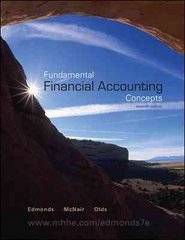Question
CASE STUDY 19: Texahoma Highway Construction Les Livingstone, MBA, Ph.D., CPA (NY & TX) University of Maryland University College Source and information: Texahoma is a
CASE STUDY 19:
Texahoma Highway Construction
Les Livingstone, MBA, Ph.D., CPA (NY & TX) University of Maryland University College
Source and information:
Texahoma is a fast-growing state in the American Southwest. The fast growth makes it necessary for the Texahoma State Department of Highways (DOH) to construct new highways and widen existing highways. The DOH carries out highway construction by means of competitive bidding by qualified highway construction companies.
One of the qualified highway construction companies is Salsa Inc. Salsa has developed and registered a patent for containing noise caused by highway construction. This noise is very loud, and DOH has to pay compensation to homeowners and businesses located near highway construction projects. The Salsa patent effectively contains construction noise, and significantly lowers the amount of compensation paid by DOH to the home-owners and businesses disturbed by the din of highway construction. The Salsa patent is for a containing wall that is built on both sides of a highway under construction. The containing wall is 16 feet high, and consists of reinforced concrete posts that are grooved to accept concrete panels with matching tongues.
The patent covers the posts and panels as a product, and also their method of manufacture. The wall is permanent, and remains to reduce traffic noise after highway construction is completed. The noise wall patent was issued in year 1.
Both the posts and the panels are manufactured onsite from molds into which are poured liquid concrete, reinforced by steel rebar. The posts are 24 feet long, with 8 feet inserted and concreted into post holes, and 16 feet protruding above ground. The posts are on 16 foot centers, and support the 16 by 16 foot panels. These Salsa walls are known as noise walls.
Since noise walls have proven very effective, DOH highway construction specifications since year 2 have included sound muffling standards that noise walls can meet, but which no competing product has been able to satisfy. When DOH introduced the sound muffling standards on January 1 of year 2, strong protests came from Salsa's highway construction competitors, who feared that they could no longer compete for contracts against Salsa, and would be forced out of business.
DOH responded by pointing out that highway contractors still had several options. They could develop new non-infringing noise walls that met the stan-dards, or they could arrange for Salsa to be their subcontractor for the noise wall portion of highway contracts, or they could purchase licenses from Salsa to use the Salsa patent in exchange for paying an agreed royalty. This satisfied some contractors, but others were resentful, and resolved not to be pushed into using Salsa as a subcontractor or licensor, or to spend money on R&D to invent new methods to muffle construction noise.
Starting on June 30, year 3, some contractors won highway contracts by infringing the Salsa patent. Each time, Salsa sent lawyer's letters to the infringers to cease and desist. But none of these letters had any effect. In order to protect its patent rights, Salsa was compelled to sue the infringers. Salsa sued the infringers for lost profits from lost sales of noise wall due to infringement.
Lost sales are sales made by infringers, but which Salsa as the patent owner should have made. Salsa's lawsuit filing also pointed out that the infringers had illegally sold noise wall at a competitive price, which was lower than the price that Salsa would have commanded as the sole supplier of noise wall. This price reduction is known by the term "price erosion."
The lawsuit was filed on December 1, year 5 and the infringements ceased by December 31, of year 5. After the defendants filed their response, there were the usual written interrogatories, depositions of fact and expert witnesses and pretrial motions. The trial was scheduled to begin on June 1, year 6 and was expected to end on June 30, year 6. Therefore damages awarded by the court would be payable on June 30, year 6. So Salsa would not recover lost profits for years 3 through 5 until June 30, year 6.
You have been asked by Salsa's lawyers to prepare its damage study to be filed with the court. For this engagement you have gathered the following information. Texahoma Highway Construction
Salsa Income Statements All figures in $'000, except per square foot and percentages.
QUESTIONS:
Estimate damages for lost operating profit for years 3 through 5 from lost sales due to infringement as of June 30, year 6, which is the estimated date of the completion of the patent infringement trial.
Should there be damages for lost profits on "convoyed" sales in this case? This is a complex legal issue, and we are not asking you for a professional legal analysis. We simply want you to apply critical thinking as best you can. Explain your answer clearly and completely, with reasoning to support your points.



Step by Step Solution
There are 3 Steps involved in it
Step: 1

Get Instant Access to Expert-Tailored Solutions
See step-by-step solutions with expert insights and AI powered tools for academic success
Step: 2

Step: 3

Ace Your Homework with AI
Get the answers you need in no time with our AI-driven, step-by-step assistance
Get Started


